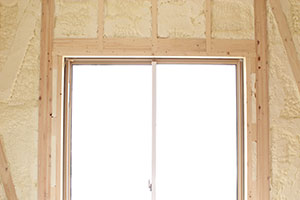ENERGY CONSERVATION IN BUILDINGS - AIRTIGHTNESS IS KEY
Nick Williams, Technical Manager, DuPont™ Tyvek® Building Knowledge Centre
Every year, over 21 billion tons of carbon dioxide is produced through human activities and the burning of fossil fuels for heating our buildings is a major contribution. It is estimated that around 32% of total UK greenhouse gases are produced in this way. There is no doubt that the way we build and manage our homes has an impact on energy consumption – therefore contributing to global warming – and it has never been more important to address those issues.
Indeed many authorities across the UK have declared a 'Climate Emergency'. The Intergovernmental Panel on Climate Change has been established, but as individuals we can also help the construction industry reduce the impact with immediate action. Energy conservation is a logical approach and making improvements in airtightness to reduce convective heat loss is a key component.
If the building envelope can be properly sealed, unintentional air movement through cracks and joints and other sources of air leakage can be avoided. Improving our methods in both design and build and adopting a 'Fabric First' approach will help us achieve these goals: Lower CO2 emissions, lower fuel bills and a carbon neutral society.
THE UK IS PLAYING CATCH UP BEHIND OTHER EUROPEAN COUNTRIES
Materials: There are often various materials, layers or components within the building element that can be used to enhance airtightness. During the design stage it is prudent to establish which components are to be used for the 'airtightness line'. Commonly, in timber and steel frame construction an external breather membrane can be used. If however, we are to address air leakage seriously, we should be looking to use an internal AVCL with superior airtightness characteristics, such as DuPont™ AirGuard® Reflective.
As it currently stands in the UK, it is quite common for our buildings to achieve air leakage levels of between 3 and 5m3/hr/m2@50Pa, which is clearly better than the 10m3 stipulated by Building Regulations. Even so, the UK is seriously lagging behind other European countries whose upper limits are very often below 1m3.
Indoor Air Quality: Living in a location where fresh air is in constant supply is ideal, but many of us live or work in urban environments where the outside air may be polluted by exhaust fumes or industry. Those with heavy road traffic are most at risk of breathing problems. Research from a  Friends of the Earth study (February 2019) confirms that there are thousands of towns and cities that exceed safety limits. Cutting down on the rate at which air flows in and out of our buildings is a logical way to establish control of our indoor environments...and help keep the noise down too!
Friends of the Earth study (February 2019) confirms that there are thousands of towns and cities that exceed safety limits. Cutting down on the rate at which air flows in and out of our buildings is a logical way to establish control of our indoor environments...and help keep the noise down too!
Ventilation: It's important to remember that good airtightness introduces a need for internal air replenishment. A healthy indoor atmosphere can only be maintained if stagnant air, bacteria, VOC's, moisture and unwanted odours are filtered out. When airtightness levels of 5m3/hr or better are achieved, mechanical extraction should be considered, whereas at 3m3/hr a heat recovery system will be needed. This tends to create some concern over installation and running costs. But on balance, the long-term energy efficiency benefits can be significant, with projected savings in heating costs of up to 20% when air-leakage rates approach Passive House levels.
DuPont manufactures a range of Tyvek® and AirGuard® membranes, air and vapour control layers, tapes and sealants, which can help us to achieve the airtightness levels the UK so desperately needs. For more information please contact our DuPont™ Tyvek® Building Knowledge Centre.
Email: tyvek.construction@dupont.com
Tel: 08444 068 722: energy-efficiency.dupont.com
- Log in to post comments















